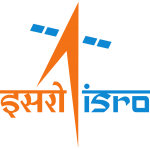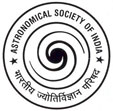June 2018:
The AstroSat Picture of the Month for June 2018 is the ultraviolet image of the merging galaxy cluster Abell 2256, more than 800 million light years away. This cluster contains galaxies spread over a large area, and we have zoomed in on six of these galaxies to show you their ultraviolet images. The brightest objects in the full image are actually foreground stars in our galaxy which happen to lie in the same direction as Abell 2256.
Picture Credits: UVIT team/ISRO/CSA.


“AstroSat Picture of the Month” is an initiative of the Public Outreach and Education Committee of the Astronomical Society of India and the AstroSat Training and Outreach Team.
Entire clusters of galaxies merging together – an ultraviolet view
Previously, we had brought you AstroSat images of individual galaxies, two galaxies merging with each other, and even a lone galaxy falling into a cluster of other galaxies. This month, we give you Abell 2256, an extremely well studied and special galaxy cluster. Abell 2256 is actually made of three separate clusters of galaxies that are all merging with each other, and will form a single massive cluster in the future. This object is at a distance of more than 800 million light years from us, and is the most distant APOM so far. The three merging clusters in Abell 2256 contains more than 500 galaxies, and the cluster is almost 100 times larger and more than 1500 times as massive as our own galaxy! This merger has produced a rich diversity of structures that have been imaged in radio wavelengths by every radio telescope in the world.
We know that galaxy clusters are places where many spiral galaxies transform slowly into lenticular and elliptical galaxies. Spiral galaxies, like our own Milky Way, are bluer in colour and are forming stars constantly. Elliptical and lenticular galaxies however, are redder and have mainly old stars in them. Abell 2256 is one such galaxy cluster where we believe many galaxies are going through this metamorphosis. Astronomers stared at Abell 2256 for 5 hours using the UVIT on board AstroSat to image these star forming spiral galaxies, using the ultraviolet light emitted by their hot young stars. The fine detail with which the entire galaxy cluster could be imaged out to its edges by UVIT is keeping astronomers busy over the last few months. They are investigating the nature of individual galaxies in Abell 2256. They also hope to understand how these galaxies will transform into lenticular and elliptical galaxies in the future.
Click here for the entire APOM archive and here to return to the latest APOM.
More about ASTROSAT
AstroSat, India's first dedicated multi-wavelength space observatory, was launched by ISRO on 28 September, 2015. It has five instruments on board – the Ultra Violet Imaging Telescope, the Soft X-ray Telescope, the Large Area X-ray Proportional Counter, the Cadmium-Zinc-Telluride Imager and the Scanning Sky Monitor.
Get answers to your common queries about ASTROSAT in English, in हिंदी, and in मराठी.

